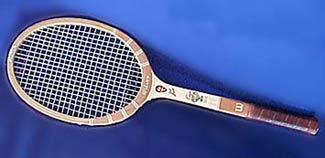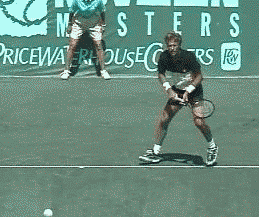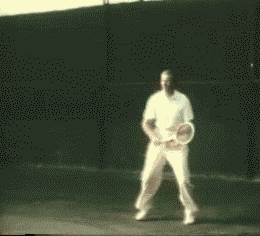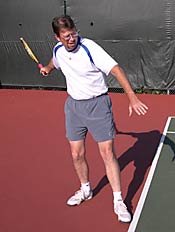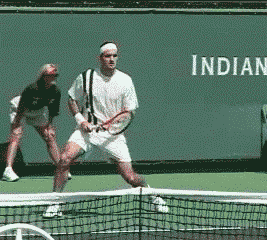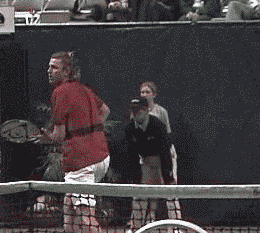TennisOne Lessons
The One Handed Topspin Backhand How We Lost the Way (Part 2) by Doug King
In my previous article on the topspin backhand, I made a suggestion that it is because of the backhand stroke that there is so much confusion over the fundamental principles of stroke mechanics. I hope to develop this idea in more detail in this article and to offer a new set of principles that are more relevant to today's playing styles. For those of us who grew up playing during the tennis boom of the 60's, tennis meant certain things. It was Jack Kramer Autographs, Dunlop Maxply racquets, and natural gut for all. Chests boasting Fred Perry crests were the attire de rigueur if you were fortunate enough to play on the country club courts. What we “parkies” shared with our well heeled tennis brethren (and there were hordes of us at the time) was the peril of having our fingertips removed by the aluminum razor ribbons we peeled with a key off the top of our cans of white tennis balls. Another thing that was a staple of tennis at the time was the constant droning from the local pro to “get your racquet back - step in - and follow through.”
Of course, this sage advice was passed on from our tennis fore fathers and seemed as much a part of the game as the height of the net and the size of the court. We practiced dutifully on backboards trying to get our racquets back faster and faster. We rallied crosscourt ad nauseam, following through over the shoulder and always, always we made sure to step into the shot. Well, somewhere things seemed to go off track. Before we knew it the nineties had arrived and a new style of play had stealthily emerged on the scene. Players were no longer stepping into the ball. Open stances were dominating the courts, along with two-handed backhands and semi-western grips. Shots were punctuated with explosive bursts from the trunk of the body (made all the more dramatic by vocal bursts that matched and sometimes overwhelmed the force from the stroke itself). Tennis started to look more like oversized ping-pong. What was happening and when did it start? The most obvious answer was Borg. Bjorn Borg was the most prolific impregnator the game had ever seen. Tiny Borg clones sprouted like weeds from parks in San Diego to swanky clubs in the Hamptons, not to mention every other continent in the world. Even girls could be seen with his trademark headband and Fila outfits. And, of course, part of the ensemble was his stylized open stance; ping-pong forehand and two handed backhand. Coaches couldn't break the devotion that bound these loyal imitators to their idol. And soon they couldn't explain the results that confirmed their worst fears - they were winning - and maybe they were right. Soon it was no longer fashionable to don the Fred Perry crest and it was equally passe to hit a Continental forehand. Flat shots all but disappeared. It is anyone's argument whether it started with Borg, or Harold Solomon and Eddie Dibbs, or Tom Okker, Manolo Santana, or Little Bill Johnston (who many claim was the originator of the “Western “ forehand and #1 in the U.S. in 1915 and 1919). There is a compelling argument that the two-handed backhand was the most significant influence. Perhaps it was because grass was replaced as the prevailing surface of major championships and the long held belief you had to slice and volley on grass to win was dispelled by Borg's Wimbledon prowess. Wherever it started this new wave of tennis had definitely come to dominate the playing style by the 21st century.
My belief is that the style of play never really changed as much as our understanding of what the fundamental mechanics of a good stroke were. If you look at Budge's backhand or Laver's forehand or Edberg's volley or Gonzales' serve, there are definite differences but what we have failed to do is to properly identify the common elements that make each stroke as great as it is. When looked at properly we can see the fundamental principles that made each great and then see a natural evolution of technique that enhances these skills from generation to generation. Grips, footwork, racquet technology, body mechanics, have all improved to enhance the fundamental principles that created success for an individual star during his or her time. The One Handed Backhand Culprit When diagnosing the evolution of tennis teaching it is important to understand the role of symmetry. I believe the forehand and the backhand are symmetrical and are subject to a symmetrical model. I also believe that symmetry has always been a goal and a means of teaching tennis but that a symmetrical application of misdiagnosed principles is responsible for much of our difficulties and confusion. Let's look at how these principles were misidentified and what the correct principles should have been. The first thing we are told to do in preparation of a stroke is to turn and get the racquet back. When you turn you have a front side and a back side and it has always been presumed that you go from back to front to create forward momentum (symmetrical approach, right?). This, however, does not take into account support and leverage of the racquet from the body. You must understand that leverage comes from behind the racquet and that the racquet is attached to the body through the arm onto a specific side of the body (the "hitting side" - see Part I). If you look at how the body can shift on the backhand side it is really quite different than on the forehand. With the right side in front of the left (after turning) the body can naturally shift from back foot (left) to front foot (right) and never lose it's position of leverage behind the handle of the racquet. Further more, on the backhand when you shift from back foot to front foot you are shifting from the non-hitting side (left) to the hitting side (right). So when you say “step into the shot” on the backhand it works out quite well. And it seems like such a reasonable request - turn, racquet back, step forward, and swing the racquet. But when we apply this formula to the forehand we end up in a world of confusion.
When we take the racquet back on the forehand there is nothing to stop it from extending away from the body. The racquet escapes in the back and takes with it both precious energy and time. On the backhand side when we “take the racquet back” the body naturally blocks the arm and racquet from going back and instead forces it to coil into the body, building up torque and compression. Here, the “racquet back” principle almost naturally unites the arm and the body into a compressed and tight coil whereas the exact opposite is true in the case of the forehand. Now we get to the next stage in the process - “step in.” Again, on the backhand when we “step in” we shift and load to the hitting side (the right). We are able to easily stay behind the arm and racquet since it is naturally in the front of the entire structure. However, when we try this on the forehand we take a bad situation created by the “racquet back” motion (extension) and make it worse by throwing the body further in front of the hands and going to the non-hitting side of the body (left). From this position the body is not supporting the wrist and not getting “into” the shot. It is also getting in the way of the comfortable extension of the arm and use of the hands. We have far too long overemphasized forward movement of the body with power, and as a key element to proper stroking. This has led to a loss of balance and premature weight shifting. Any baseball player knows that if the weight shift gets in front of the hands tremendous power is lost. Because of our association of forward body movement with power we have ended up putting the body into the role of increasing the swing of the racquet head. Add to that our infatuation with racquet speed and following through and we have an almost sure-fire recipe for disaster. The result is overextension in the backswing, premature weight shift and excessive forward lean and twisting, far too much momentum in the racquet head resulting in slapping into the ball and pulling off the ball too quickly in order to get to a follow through.
The New Model Today's players subscribe to a totally different formula. First, players today understand weight shift and the hitting side. The weight is held back behind the hands. There is very little forward stepping on the forehand and the weight shift is always saved for the actual contact of the ball. The weight shift is more of a vertical lift of the hitting side and extension of the arm, as opposed to a forward shift and turn of the body. The backswing is modulated so that the racquet head does not escape during the loading of the hitting side. This allows the body to maintain better balance and to flow more gracefully. Better balance means better coordination and so not only does the body move better but the eyes also focus better on the ball. Racquet work is different today. The racquet is brought into contact to establish connection to the ball rather than swing against the ball to create force through impact. By defining the role of the racquet as "connecting" to the ball instead of "swinging" at the ball, the racquet position can be kept more forward of the hitting side (since the back and forth swing of the racquet has been reduced ) and it allows the hand and arm to stay relaxed longer and to "adjust" to the ball better, making timing the ball much easier. The old style required the swing to commit to a forward horizontal swing plane too soon making it difficult to adjust it on a vertical plane which led to mis-hits. With the newer techniques the racquet is held more forward to the body where there is less risk of being late since "late" is when the body is in front of the racquet. Today the racquet is well managed on the ball as power is released through extension or compression from the hitting side. The ultimate follow through position is relatively immaterial and almost an inadvertent byproduct of the push and turn of the ball as opposed to something that one swings to. Since the players today are more focused on connecting on the ball and pushing and turning the ball rather than swinging to a follow through position, they can actually focus on the contact itself instead of some point “over the shoulder.”
The Rules of Engagement Probably the most difficult part of this process of ball stroking is to get the racquet and the ball to connect properly. I refer to this as "engagement." Think of the ball and the racquet working like gears meshing together. The ball is not smooth and certainly the strings are not, so there is friction and surfaces that can engage. Anybody who played against the now outlawed Michael Fishbach "spaghetti strings" of the late '70's knows how true this is. How to get these surfaces to mesh is what I refer to as “The Rules of Engagement.” While most players approach the ball with the idea of hitting it, I think a better way is to come to the ball with the idea of engaging onto it. Once we start “hitting” we are essentially unable to adjust to the ball; we even tend to stop looking at the ball. That is, we go into an active hitting mode. Better players approach the ball for a much longer time in a reactive adjusting mode. The actual hitting is saved for later. This is what allows good players to watch the ball longer and to adjust to the ball better. They stay in this reactive adjusting mode much longer. When we swing too fast without engaging we are essentially spinning our gears. When we “go out” to the ball we must be careful that we are not committing our weight shift or accelerating to the point of spinning our gears. "Hitting" the ball is simple if you can engage on it. "Engaging" on the ball is the far more tricky part. | |||||||||

